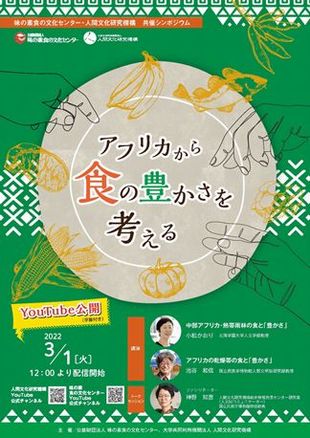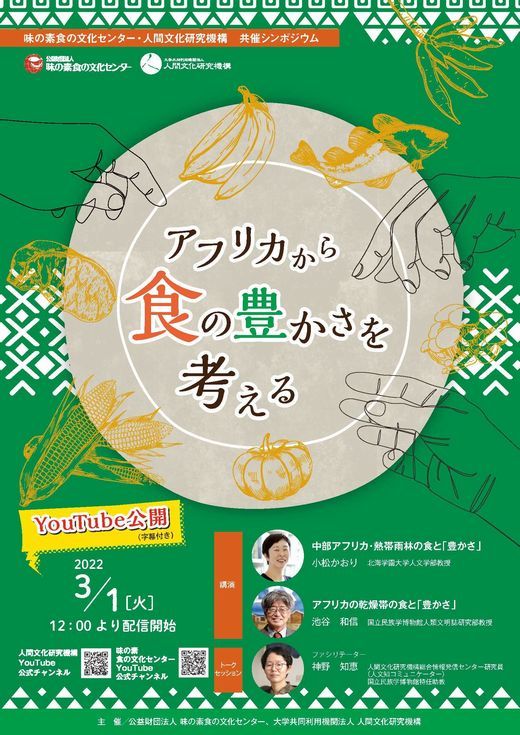Joint Symposium by the National Institutes for the Humanities and the Ajinomoto Foundation for Dietary Culture: “Thinking About Abundance in African Culinary Culture”

The National Institutes for the Humanities (NIHU) is pleased to announce the fifth symposium to be held in collaboration with the Ajinomoto Foundation for Dietary Culture. Presentations at this year’s symposium were delivered around the theme of “Thinking About Abundance in African Culinary Culture.” Like last year, to avoid the possible spread of infectious disease, the symposium was not held in person, but rather recorded in advance for online broadcast. The video presentations, recorded on November 25, 2021 through cooperation with the National Museum of Ethnology and Hokkai-Gakuen University, were published on March 1, 2022 on the YouTube channels maintained by NIHU and the Ajinomoto Foundation for Dietary Culture.
The program of this year’s symposium is as follows:
| [Introductory Outline] | Ikeya Kazunobu |
| (Professor, Department of Modern Society and Civilization, National Museum of Ethnology) | |
| [Lectures] | Komatsu Kaori |
| (Professor, Faculty of Humanities, Hokkai-Gakuen University) | |
| “Food and ‘Abundance’ in the Central African Rainforest” Ikeya Kazunobu | |
| “Food and ‘Abundance’ in Africa’s Arid Zone” | |
| [Dialogue] | Facilitator |
| (Specially Appointed Researcher, National Institutes for the Humanities National Museum of Ethnology, Liberal Arts Communicator) | |
| Panelists | |
| Komatsu Kaori, Ikeya Kazunobu |
To start things off, Dr. Ikeya outlined the purpose of this session, which was namely to divide the continent into a wet zone comprised by Central Africa and an arid zone of East and Southern Africa in order to give concrete consideration to the kinds of culinary culture that have emerged in Africa, where views are often colored by preconceived notions of hunger and poverty in the context of rapid population growth.
The first presentation was delivered by Dr. Kaori Komatsu on the theme of “Food and ‘Abundance’ in the Central African Rainforest”, with a focus on the diversity of agriculture and cuisine in West and Central Africa. In sub-Saharan Africa, the staple diet consists of cereals and vegetative crops such as cassava, yams and plantains that are prepared in ball-shaped portions. In the rainforests of Cameroon and the Congo in Central Africa, in addition to a combination of vegetative crops grown in shifting fields, dishes are prepared with a variety of fish, insects, and wildlife from the forests and rivers, as well as oil palm, a cultivated wild plant. Although the methods of preparing and combining these materials allow variation in flavor, the combination of ingredients and seasonings conforms to a very particular flavor profile. Abundance seen from this perspective not only pertains to the content of a dish, such flavor profiles or a personal preference for staple foods, or “eating a variety of foods,” but also places emphasis on the act of co-eating, which is to say the act of sharing dishes together with guests eating from a single plate. Although the practice of co-eating is not limited to Africa, Komatsu points out that sharing meals is an important condition of food abundance for the people and that it represents a form of eating that can be shared indefinitely.
The next presentation, by Dr. Ikeya on “Food and ‘Abundance’ in Africa’s Arid Zone” constituted an attempt to rethink the “abundance” of local culinary culture in the arid zone of Africa, which is often perceived in the context of drought, hunger, and poverty. The talk began with a focus on the various culinary cultures of Kenyan pastoralists (Somalis), Zambian agriculturalists (the Chewa), hunter-gatherers in Botswana (the San), and urban residents in South Africa (Xhosa), all of whom have ethnonyms corresponding to their regions and modes of subsistence. For example, Somalis consume camel’s milk as a staple food while the Chewa eat maize.
Dietary habits are practiced according to the subsistence and living environment, as seen among the San, who have come to rely on dairy in the context of their shift to a sedentary lifestyle from wild ingredients obtained in the context of a nomadic lifestyle, while Xhosa who have moved from farming villages to cities use maize flour that they have purchased at local kiosks. Here, it is important to point out that the Xhosa, who have moved to the cities, abandoning their traditional modes of subsistence, have retained the custom of co-eating in their everyday lives, attesting to a continuity of food culture that transcends time and living conditions. In the context of rapid increases in the African population, particularly among urban populations in developing countries, African culinary traditions live on in modern society, even as they begin to be prepared in new ways, while the custom of “co-eating” is maintained in the changing social structure. Herein, we can see one of the aspects of the “abundance” of African culinary culture.
The presentations by Dr. Komatsu and Dr. Ikeya were followed by a dialogue moderated by Dr. Kamino. As might have been expected, the discussion turned on the key themes of food “abundance” and “co-eating” as one of the enabling conditions thereof. In some areas, however, co-eating is restricted or complicated by forms of governance, social hierarchies, gender differences, or religious prohibitions.
There is also a commitment to “our food”, a symbol of the “abundance” of food, and cooking techniques that create a local taste. A lively exchange of views took place on how, in addition to crops like sorghum, finger millet, yams, and okra, which originate in Africa, other crops like plantain and taro from South East Asia and cassava and maize from South America have also actively been introduced as ingredients and have taken root in the African diet to create new culinary identities, which in turn leads to “abundance.”
We believe these presentations on African food culture represent an important starting point for rethinking the nature of food culture in terms of the essential characteristics of humanistic food, as well as other aspects including ingredients, cooking, and eating spaces.

Symposium leaflet
Text: Nagamura Makoto, CIP Director, and Executive Director of NIHU
